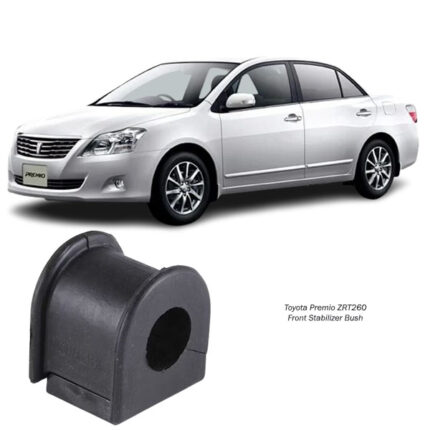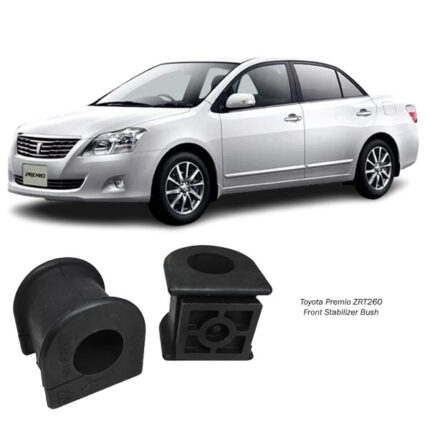Get Toyota Premio ZRT260 Front Stabilizer Bush 48815-20290 in Kenya
When it comes to vehicle suspension systems, most drivers know about shocks, springs, and maybe even struts. But there’s one component that works silently in the background, keeping your ride smooth, your handling tight, and your tires firmly planted—it’s the front stabilizer bush. 🧩
Small in size, but big in impact, this rubbery little component plays a huge role in your car’s comfort and control. Let’s explore what it does, how it works, and why replacing it when worn is essential for vehicle performance and safety. 🔧
🌀 What is a Stabilizer Bush?
A stabilizer bush—also called a sway bar bush or anti-roll bar bushing—is a cushion-like component made of rubber or polyurethane. It holds the stabilizer bar (also known as the sway bar or anti-roll bar) securely in place and allows it to flex while preventing metal-to-metal contact. 🌐
In the front suspension, this bush is mounted between the stabilizer bar and the vehicle’s frame or chassis. It reduces noise and vibration while allowing the bar to twist as the wheels on each side of the vehicle move independently.
🔄 How the Stabilizer Bar Works
Before diving deeper into the bush, let’s quickly understand the stabilizer bar itself.
The stabilizer bar connects the left and right sides of a vehicle’s suspension. When one wheel hits a bump or dips into a pothole, the bar resists the resulting tilt by transferring some of the movement to the opposite side. This keeps the vehicle flatter in turns and more stable during uneven driving conditions.
Without it, your car would lean excessively in corners or feel unstable during sudden maneuvers. 🌀🏎️
🧽 So Where Does the Bush Come In?
The front stabilizer bush plays a critical role in this setup:
-
It holds the stabilizer bar firmly in place, allowing it to pivot only when needed.
-
It absorbs vibrations, reducing noise and harshness.
-
It minimizes friction between the bar and the chassis.
-
It helps maintain suspension geometry and improves steering response.
These bushes are often installed in pairs—left and right—right around the curved portions of the stabilizer bar and secured with brackets.
🧱 Materials: Rubber vs. Polyurethane
There are typically two materials used for stabilizer bushes:
🔹 Rubber Bushes
-
Quieter and softer
-
Offer a more comfortable ride
-
Ideal for daily driving
-
Wear out faster under tough conditions
🔸 Polyurethane Bushes
-
Firmer and longer-lasting
-
Provide better handling and feedback
-
Great for performance setups
-
Slightly noisier and may require lubrication
Both have their place, depending on the vehicle’s use and the driver’s preferences. 🛣️⚙️
🧠 Why It Matters: The Benefits of a Good Stabilizer Bush
Although small, the front stabilizer bush is critical to maintaining:
✅ Vehicle Stability
It keeps the sway bar aligned, helping your car stay balanced in turns and during quick lane changes.
✅ Comfort and Quietness
It isolates vibrations and noise from the stabilizer bar, keeping the ride smooth and quiet.
✅ Steering Precision
A worn bush can lead to vague steering. A good one enhances responsiveness and road feel.
✅ Suspension Health
It reduces stress on the sway bar and suspension joints, extending their lifespan.
In short, this humble component helps tie your entire suspension system together. 🤝
🚨 Signs of a Worn Front Stabilizer Bush
Like all rubber components, stabilizer bushes degrade over time—due to heat, moisture, road salt, and general wear and tear. Here are the most common symptoms of a worn or damaged bush:
1. Clunking or Rattling Noises 🔊
You might hear strange noises coming from the front of the vehicle, especially when driving over bumps or turning sharply.
2. Excessive Body Roll 🌀
The vehicle may lean more than usual during turns, indicating the stabilizer bar isn’t being held securely.
3. Loose or Unstable Handling 🏁
Steering might feel sloppy or disconnected, particularly when changing direction quickly.
4. Visible Cracks or Gaps 🔍
During an inspection, you may see splits, cracks, or deterioration in the rubber material.
5. Uneven Tire Wear 👟
Worn bushes can affect suspension geometry, leading to premature tire wear.
🔧 Replacing the Front Stabilizer Bush: What to Expect
Luckily, replacing stabilizer bushes is generally straightforward and affordable. Here’s how a typical replacement goes:
Step 1: Lift the Vehicle 🛞
The car is safely raised to access the underside of the front suspension.
Step 2: Remove Mounting Brackets 🔩
The brackets holding the bush in place are unbolted, revealing the old bushes.
Step 3: Inspect and Clean the Area 🧼
The sway bar and mounting surface are cleaned to remove dirt and corrosion.
Step 4: Install New Bushes ✨
Fresh bushes are fitted onto the stabilizer bar, ensuring a snug fit.
Step 5: Reattach Brackets and Test Drive 🧪
Brackets are torqued to spec, and the vehicle is test-driven to confirm noise reduction and improved stability.
🛡️ When to Replace Them
Front stabilizer bushes don’t have a set replacement interval, but many mechanics recommend inspecting them every 40,000 to 60,000 km—especially if you drive on rough roads or notice any of the symptoms above.
If you’re replacing other suspension parts (like sway bar links or control arms), it’s often wise to replace the bushes at the same time. ⚙️🔁
🧰 Maintenance Tips for Long-Lasting Bushes
Want to keep your stabilizer bushes in top condition? Here’s how:
-
Avoid harsh driving: Sudden turns and potholes speed up wear.
-
Inspect regularly: Especially after long off-road trips or rainy seasons.
-
Clean the undercarriage: Salt and mud can eat into rubber parts.
-
Use quality parts: Cheap bushes wear quickly and can cause handling issues.
-
Listen to your car: Unusual noises are often early warnings. 🔊🚨
🔚 A Small Part With a Big Job
The front stabilizer bush might seem like just a rubber donut, but its role in ride comfort and handling is huge. It works silently with your sway bar to keep your vehicle level, planted, and predictable—especially when the road gets twisty. 🛣️💨
A fresh set of stabilizer bushes can restore that “new car feel”—eliminating clunks, improving cornering, and making every drive smoother and safer.
So the next time your mechanic mentions it’s time to replace your sway bar bushes, you’ll know exactly why it matters.
Follow us on Facebook for more parts.





Reviews
Clear filtersThere are no reviews yet.